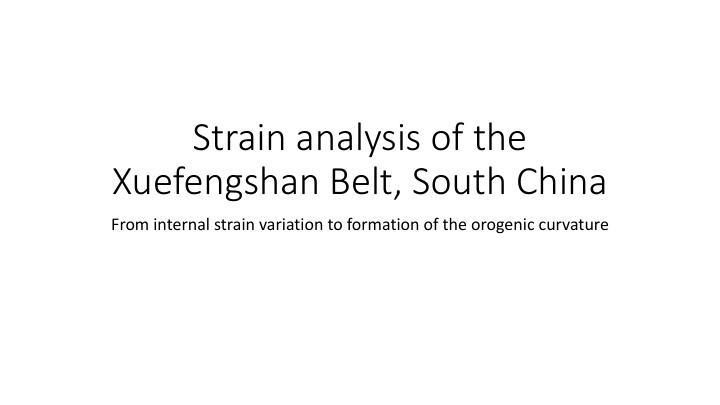



Strain analysis of the Xuefengshan Belt, South China From internal strain variation to formation of the orogenic curvature
Introduction: the concept • Structures at multiple scales may reflect different information for quantification. • Balanced cross-sections provide shortening estimation based on km-scale • Strain measurements closely depend on micro-scale to hand size samples • Due to heterogeneity, differential deformation give rise to various structural modes of fold-and-thrust belts. • Quantitative strain data reveal the strain variation of the Xuefengshan Belt, and then allow the geometry and evolution of this intracontinental belt.
The problem and what they seek to further understand • Although the architecture of this belt has been well documented information on the internal strain patterns and how they evolved in the intracontinental setting remain less understood.
Geological setting: the tectonics South China block occurred following the Collision between the Yangtze Block and the Cathaysia Block SCB was confined and intensely modified by periphal orogenic belts: Qinling-Dabie, Longmenshan belt Indosinian orogen The Xuefengshan Belt formed a tremendous intracontinental belt characterized by NE-SSW trending folds and faults with an overall northwest vergence
Stratigraphy & deformation Deepest layer is the Mesoproterozoic- Neoprotozoic series, further subdivided • Lengjiaxigroup • Banxi group • Sinian group Xuefengshan Belt • Has a western and eastern zone • Main Xuefengshan thrust(MXT) • Metamorphosed rocks on east zone • Non-metamorphosed on west zone Western zone • Box folds Eastern zone • Polyphase deformation but can be regarded as continuous and cumulative
Ductile deformation of the Decollement • High strain zone • Uplifted by the emplacement of late Triassic granites, subsequently was exposed to the surface by erosion • There was a single NW-SE contraction event in the decollement zone. A study suggest that the deformation in the decollement main occurred during the middle Triassic that coeval with the timing of deformation in the sedimentary cover.
Neoproterozoic conglomerate Lowest stratigraphic unit Contains penetrative, closely-spaced schistosity. Structural elements include bedding and lineation and show similar geometric and kinematic features as those in the whole belt Upper tectonics levels • random orientation, low deformity 4a,5a • High deformity sparsely spaced cleavage but pebbles still remain undeformed and unrated 4b • When approaching the decolement, is strongly sheared with penetrative schistosity and elongated pebbles, shearing structures 5c, 4 c-e
Methods for Strain estimation • 48 samples were taken • In the study area, despite the polyphase deformation, consistent kinematics during the Triassic orogeny has been observed in the Xuefengshan Belt, They assumed theses phases as one continuous deformation, and thus 2D strain analysis in XZ and YZ planes can reflect the strain ellipsoid in selected samples
Methods of experiment • Measured clasts in thin sections, and then obtained strain ratios for all samples • Two oriented thin sections were cut from rock samples in the XZ and YZ planes of finite strain (XZ: perpendicular to the foliation and parallel to the lineation; YZ: parallel to the foliation and perpendicular to the lineation. • To estimate finite strain, the Rf/ψ method was adopted • Rf/ψ measured the strain accumulated within the matrix as better of the bulk strain • Rf represents aspect ratios of the final shapes of clasts, and ψ is the angle between the long axis of clasts in the deformed rock and the reference line
Strain analysis results • Separated the samples of the Banxi group into two subgroups (1) Banxi group-M, metamorphosed under greenschist facies (2) Banxi group, free of metamorphism, • Three orogen- perpendicular sections are chosen to evaluate in detail the deformation mode and variation in the belt.
North section • 12 samples of which 10 have the longest R s parallel to mineral stretching lineation in NW-SE orientation • Samples plot in the flattening field of Flinn diagram
Middle section • This region is characterized by a fold and thrust system upon the buried decollement at depth, resulting in duplexing and significant upper crustal shortening. • The longest R S parallel to mineral stretching lineation in NW-SE • On the Flinn diagram, all 11 samples plot in the flattening field
South Section • D2 back thrusting and back folding dominates to the southeast of the MXT • Most samples plot in the flattening field of the Flinn diagram similar to the results from the North and Middle section.
discussion • Almost all samples are plotted in the flattening field, indicating that thrust-normal flattening mechanism dominates the strain propagation • Differences • Middle & south section many of data plot near plane strain suggesting that a higher thrust- parallel shearing component • North section includes mostly thrust-normal flattening with some minor thrust parallel shearing • Low magnitude orogen-parallel stretching may develop firstly in the outer part of the Xuefengshan Belt and strain ellipsoids are modified by subsequent shortening, but some initial feature is preserved due to the heterogeneity of deformation intensity.
Discussion • A systematical variation dependent on structural positions • As a whole, bulk strain of analyzed samples gradually intensifies from the upper unit (Nantuo and Jiangkou formations) to the lower unit(metamorphic Banxi Group)
Strain variation • Deformation intensity and strain decrease from the east to the west, and drop significantly to the west of the Main Xuefengshan Belt, which marks the major boundary between the western Zone and Eastern Zone of higher and lower tectonic levels. • Inhomogeneous deformation during the propagation of the belt occurred. • Strain ratios in the middle show low R values • Strain ratios in the northern and southern show high R values
conclusi sions • Accompanying the incremental deformation, the linear belt propagated toward the west, but encountered the Early Paleozoic batholiths that acted as rigid blocks. Consequently strain was transferred to the west of the batholiths and resulted in high strain ratios in the north and south sections. • Such structural patterns reflect an interacting process between the thrust wedge and batholith barriers that created the curvature of the Xuefengshan Belt
Recommend
More recommend